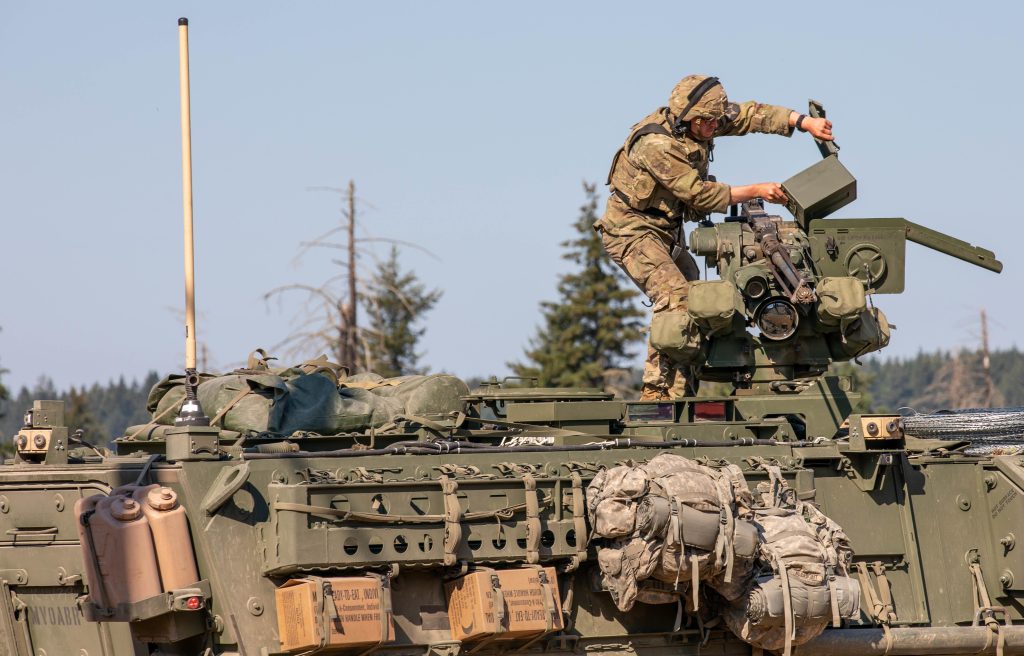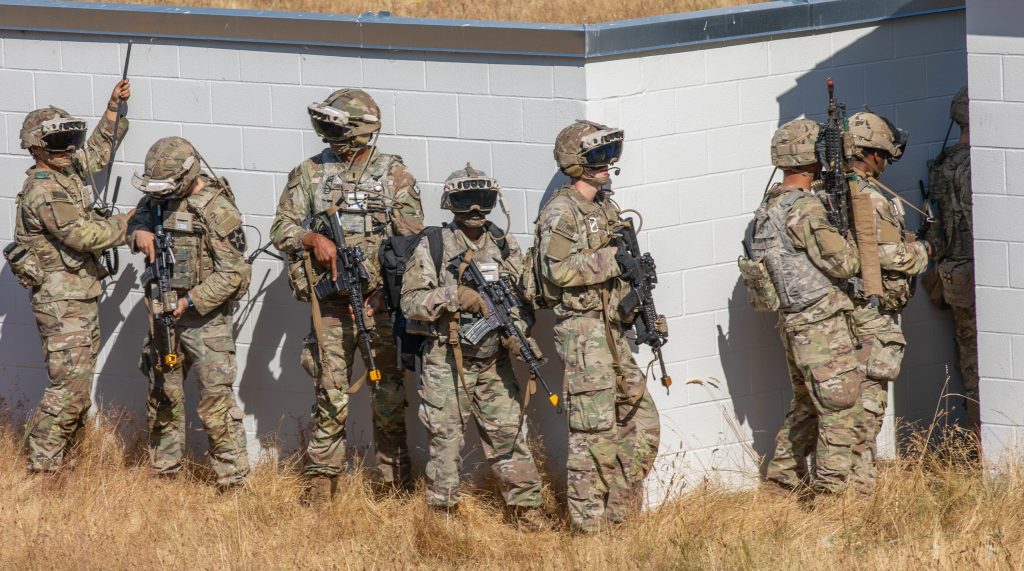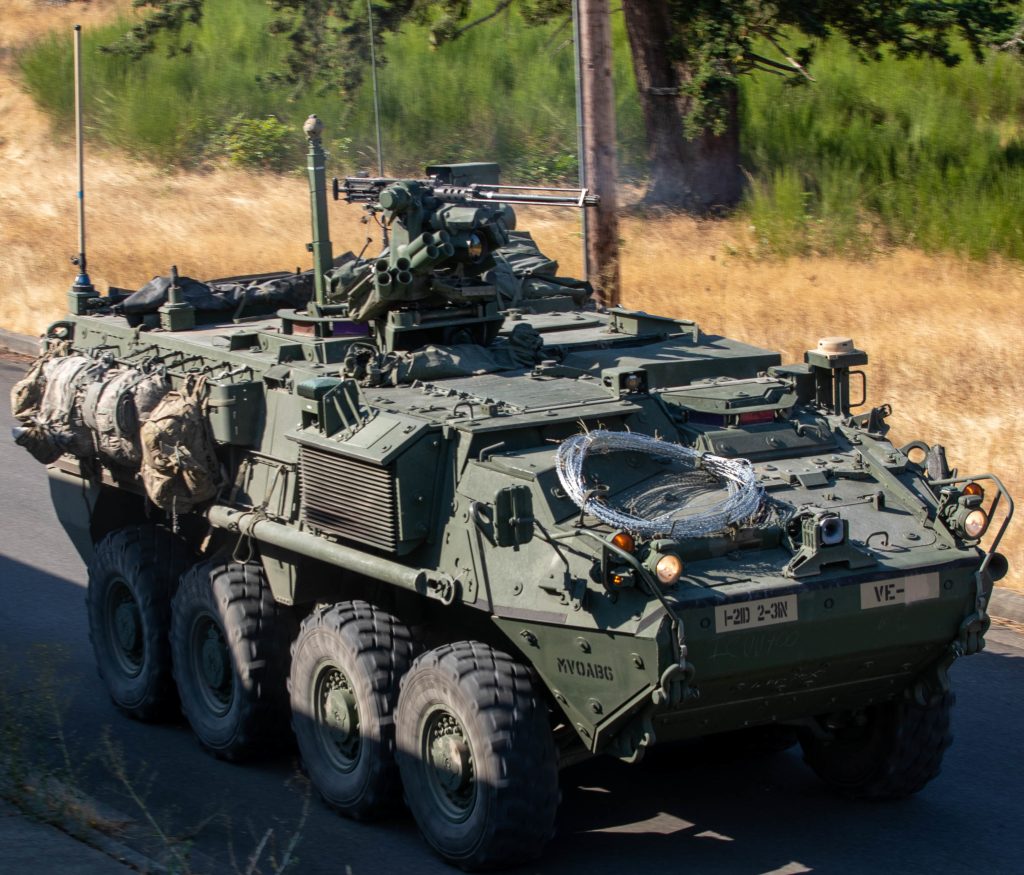
NECESSARY PREPARATIONS: Soldiers with Third Platoon, “Blackhorse” Company, 2nd Battalion, 3rd Infantry Regiment, 1st Stryker Brigade Combat Team, 2nd Infantry Division wear upgraded Integrated Visual Augmentation System goggles while sitting inside a Stryker armored vehicle preparing for a movement-to-contact urban raid exercise on Joint Base Lewis-McChord, Washington, August 24, 2022. (Photos by Spc. Chandler Coats, 5th Mobile Public Affairs Detachment)
Four program executive offices team up with Soldiers from 1-2 Stryker Brigade Combat Team to run the Army’s most modern platform, communications and data interface programs of record through the paces.
by Lt. Col. Nicholas Breen, Capt. Max Meinert and David Morris, Ph.D.
On a hot August day at Joint Base Lewis-McChord, Washington, Soldiers from 3rd Platoon, Bravo Company, 1-2 Stryker Brigade Combat Team stressed their operational limits to see what capabilities the Army’s most modern programs of record offered. The combined kit from the Program Executive Office for Ground Combat Systems (PEO GCS); PEO Command, Control and Communications ‒ Tactical (PEO C3T); PEO Intelligence, Electronic Warfare and Sensors (PEO IEW&S) and PEO Soldier provided a cool breeze through the fog of war. Data radios, vehicle cameras and augmented reality headsets gave the platoon unprecedented situational awareness, increasing its lethality and allowing for better informed tactical decisions.
“The situational awareness that leaders are able to gain and maintain with minimal effort greatly enhances our ability to operate,” said Sgt. First Class Kyle Williams, rifle platoon sergeant for 3rd Platoon.
The vehicle excursions hosted every two to three years by PEO GCS are prototyping events that test mature technologies ready for fielding. The intent is to reduce platform integration risk, cost and schedule, and ultimately to get mission-enhancing technology into the hands of Soldiers as soon as possible. Vehicle Excursion 3 (VE3) incorporated multiple PEO capabilities into a system of systems suite of equipment, taking the next step in providing unified data and communications on platforms at the forward edge. “We realized early in the planning process for VE3 that the combat platforms presented a unique challenge, as separate markets or end users on the platform had different needs,” said Bob McNeill, project lead for the PEO GCS integration office. “The platform crew, dismounts and the formation are all hungry for data, and there is not a unified effort to tie all of these technologies together at the platform level outside of the vehicle excursions.” Picture your car dashboard, sensor and infotainment system being developed by separate entities without a clear plan on how it would all function together. Then you can quickly grasp how we’ve approached integration in the past.
Some key platforms and products Soldiers leveraged at VE3 were:
- The Stryker Double V-Hull A1.
- The Integrated Visual Augmentation System (IVAS) (based on civilian augmented reality technology).
- Enhanced Night Vision Goggle ‒ Binocular.
- Power On-The-Move.
- A Universal Battery Charger.
- A 360-degree camera system for use by both crew and dismount subsystems.
- Assured position navigation and timing systems.
“VE3 presented the IVAS program an opportunity to validate its capability in a larger ecosystem of mature programs of record while cutting cost for platform integration of participating programs,” said Col. Troy Denomy, project manager for the PEO Soldier IVAS.

READY FOR RELOAD: A Soldier reloads the mounted .50 caliber machine gun on his Stryker armored vehicle during the vehicle excursion exercise on Joint Base Lewis-McChord, Washington, August 24, 2022.
CONCEPT OF OPERATIONS
3rd Platoon, Blackhorse Company was selected to conduct VE3 and to provide Soldier inputs to identify critical operational issues. 3rd Platoon was given five weeks of new equipment training prior to executing team-, squad- and platoon-level training exercises over a two-week period. Soldiers were issued IVAS headsets and Tactical Scalable Manet (TSM) handheld voice/data radios (TSM is a new waveform allowing data sharing between vehicle and dismounted users, automatically relaying both to extend range throughout a unit). Vehicles were equipped with mounted TSM radios, 360-degree situational awareness camera systems, and additional charging equipment for Soldier-worn batteries. The training scenarios were focused on offensive operations in urban terrain that transitioned to consolidation and establishment of a defense. Each iteration involved troop-leading procedures and some incorporated rapid changes of mission during execution caused by updates to the enemy’s disposition.
After-action reviews and human factors psychologist interviews followed each scenario to capture Soldier feedback. Soldiers reported issues and recommended improvements to reshape systems before fielding:
- TSM radios had limited range and short battery life but were reliable and clear. The limited range is a mixed blessing—they do not reach as far as the current Single Channel Ground and Airborne Radio System, but the limited range decreases their electromagnetic signature, making them more difficult for the adversary to detect on the battlefield.
- IVAS provided superb thermal vision and revolutionary mission command capabilities, but the current cabling restricted Soldier movement, and the large goggles are not compatible with current weapons optics. The IVAS heads-up display is specifically relevant at the platoon level and below because it does not require the user to look down at a smartphone.
- Power On-The-Move had connector issues that caused repeated system reboot. Because of this, Soldiers avoided using it.
- The Universal Battery Charger quickly charged batteries from the Strykers. It is a much-needed capability, especially as future systems increase battery dependence. This increased dependence will tie infantry platoons closer to their power generation and increase fuel consumption as engines will need to run more frequently.
- 360-degree cameras were found to be most useful by vehicle crews to maintain situational awareness and security in urban terrain.
The overall conclusion was that with some additional work to tweak final designs, the IVAS, new Tactical Assault Kit (TAK) mission command software, and network system of systems tested during VE3 will allow Stryker Brigade Combat Teams and warfighters to compete and win on the battlefield of the 21st century. The accurate and automatically updating common operating picture created by IVAS and the newest mission command software, TAK, allows platoon leaders and company commanders to better synchronize and rapidly maneuver their combat power.
It also allows higher headquarters to passively track the progress of operations. Instead of commanders and staffs at every echelon spending a significant amount of time working to gain and maintain situational awareness, that time can be devoted to anticipating and shaping the future fight. Pushing their operational capability demonstrated that every squad leader having access to a better common operating picture than a Desert Storm-era battalion commander allows them to take disciplined initiative to accomplish their mission. It increases the ability of the Army to exploit the inherent strengths of its noncommissioned officer corps and junior officers. The tactical advantages provided by improved versions of these systems will far outweigh the disadvantages.

PREPARE ACCORDINGLY: Soldiers wear upgraded Integrated Visual Augmentation System goggles while preparing to storm the objective building during the vehicle excursion exercise on Joint Base Lewis-McChord, Washington, August 24, 2022.
Vehicle Excursions and Mitigating Risks in Modernization
The Future Combat Systems era of modernization is often cited in Army circles as a monolithic “top-down” institutional failure, given its reliance on unproven technology and the risk associated with “leap-ahead” technologies. As the Army allows its leap-ahead technologies to mature independently in the current modernization effort, a “bottom-up” approach of proving individual technologies before adoption avoids the previous failures of immature systems. However, a focus on individually maturing new capabilities creates a risk in unity of effort, synchronization and integration. These are particularly critical to the tightly interwoven constrained spaces of ground combat platforms. Several efforts can mitigate these risks:
- First are the PEO-level integration shops. Project Lead Capability Transition & Product Integration Office is the O6 level integration shop for PEO GCS, established in October 2020. Similar integration activities (with slight mission distinctions) exist at PEO Aviation in the Aviation Mission Systems and Architecture Project Office, at PEO IEW&S in their Integration Directorate, and at PEO C3T in the Project Manager for Interoperability, Integration and Services. PEO Soldier is currently standing up its own version. Without the integration stakeholder communities’ efforts across program lines and communicating on cross-portfolio funding opportunities, no one would be minding the wheel on the bottom-up approach.
- Additionally, PEO GCS is developing reference implementation architectures starting with current state and extending to mid- and long-term milestones toward the modernization goals of Army 2030 and beyond. A key element is the Modular Open Systems Approach (MOSA), and the PEO GCS instantiation GCS Common Infrastructure Architecture, aka the “digital backbone.” To understand what this means, picture a networked flip phone, handheld GPS unit, handheld digital organizational assistant, and many other devices being what you take into combat. These are all yesterday’s technologies and yesterday’s methods of integrating systems. A digital backbone such as is found in an interconnected smart home, touch screen smartphone or modern electric vehicles, is the direction MOSA will take us.
- Another element is the physical integration space—the Standardized A-Kit / Vehicle Envelope (SAVE), recently signed by the Army acquisition executive, Douglas R. Bush, which provides a common physical space, environment and interface characteristics for radios, computers and other new technology. Led by PEO GCS and co-developed by all the PEOs represented at VE3, SAVE will enable more rapid modernization, because new SAVE-compliant systems will already be compatible with SAVE-compliant vehicles.
- The final key effort mitigating integration risks are the vehicle excursions. An important distinction and unique value of VEs is the focus on mature technologies. While Project Convergence and other technology demonstration events have proven valuable at demonstrating what is in the art of the possible, VEs operate in a post-Project Convergence environment with mature technology—answering the question, “What are we really going to fund for modernization, how does it all connect, and does it work as advertised?” Installing multiple systems on platforms in an operational environment quickly brings out the technical and programmatic “warts,” allowing much faster redesign more affordably, while providing a government-owned technical data package at the system of systems level at the end of the vehicle excursion. Most importantly, the Soldier feedback received at VEs is the only Soldier touch point for ground platforms at the system of systems level before nonrecurring engineering. This final “gut check” ensures that information dimension nonrecurring engineering funding is improving access to relevant real-time information and reducing cognitive load, truly making Soldiers more lethal on the battlefield.

STORM READY: A Stryker armored vehicle fires its .50 caliber machine gun while storming the objective during a vehicle excursion event on Joint Base Lewis-McChord, Washington, August 24, 2022.
CONCLUSION
The pace of modernization and rearmament is accelerating across the globe. System of systems integration, standardization and mature prototype excursions are critical enablers to accelerate our own modernization. The lessons learned from VE3 will improve modernization of information dimension systems as the Army moves toward Army 2030. The tactical benefits of new systems need to outweigh the overall cost of using them in terms of added Soldier load, reliability, ease of use, training time, access to training and sustainability. Future vehicle excursions will continue to bring this type of wisdom into the Army acquisition process.
COL. NICHOLAS BREEN, product lead for PEO GCS Ground Combat Platform Integration, has an M.A. in liberal arts from Johns Hopkins University, a B.A. in political science from the University of Nebraska, and will be attending the Eisenhower School for Senior Service College. He served as an assistant product manager at PEO Soldier, has served on the staff of the assistant secretary of the Army for acquisition, logistics and technology, and is currently serving as the product lead for integration of C5ISR Products onto Ground Combat Platforms.
CAPT. MAX MEINERT is the outgoing company commander for Bravo Company, 1-2 Stryker Brigade Combat Team. He has a B.S. in military history from the U.S. Military Academy at West Point. He commissioned as an infantry officer in 2013 and is in the process of transitioning to strategist. He has served in the 1st Battalion, 508th Parachute Infantry Regiment, U.S. Army Europe G-5, Special Operations Joint Task Force ‒ Afghanistan, 1-2 Stryker Brigade Combat Team and the Stryker Warfighters’ Forum.
DAVID MORRIS, PH.D. is a network integration engineer and the lead for MITRE support to PEO GCS assisting with combat vehicle modernization. He holds a Ph.D. and M.S. in electromagnetics with a minor in communications, and a B.S. in electrical engineering from the University of Michigan, Ann Arbor.







